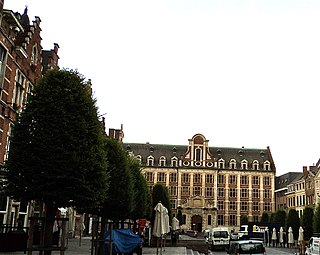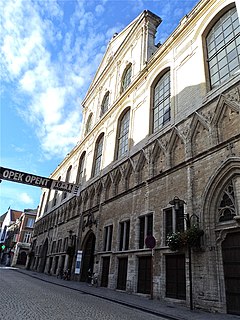 W
WBeschermd erfgoed is the official term to describe Flemish National Heritage Sites listed by law to protect and spread awareness of Belgian cultural heritage, specifically in Flanders. The term is also used nationwide to refer to national heritage sites. Because Belgium is officially a tri-lingual country, the other nationwide terms used in the rest of the country are the French term Bien classé and the German term Kulturdenkmal.
 W
WThe church of Our Lady, Melsele is a Roman Catholic parish church in Melsele, in the commune of Beveren, in East Flanders, Belgium. It is a registered heritage site.
 W
WThe Flanders Heritage Agency is a cultural heritage agency sponsored by the Flemish Government. The organisation is split into four subdivisions; the former VIOE, which inventories Beschermd erfgoed in the Flemish Region; the agency "Ruimte en Erfgoed" which executes policy on heritage management and protection; the Ministry department of Town and County Planning, Housing Policy and Immovable Heritage, or Ruimtelijke Ordening, Woonbeleid en Onroerend Erfgoed (RWO), which supports the Minister of Culture on policy decisions; and Inspectie RWO, which is the inspection arm of the RWO.
 W
WThe Gordon Monument is a neoclassical monument to a slain warrior on the battlefield of Waterloo. The person commemorated is Lt Colonel Sir Alexander Gordon (1786–1815). It was erected in 1817 by the siblings of the deceased who included a future Prime Minister, Lord Aberdeen.
 W
WHoly Ghost College was one of the colleges of Leuven University, now listed as built heritage of Flanders, Belgium.
 W
WHuisje Mostinckx is a farm on the village square of Sint-Martens-Bodegem, a subdivision of Dilbeek in Flemish Brabant, Belgium. The date of building is unknown, however mentions on the Ferraris maps of Belgium date it prior to 1777. The house is a Flemish protected monument since 1981.
 W
WKortenberg Abbey, sometimes referred to as Cortemberg Abbey, was a monastery of Benedictine nuns at Kortenberg in the Duchy of Brabant. It is now a diocesan retreat centre under the name OAK: Old Abbey of Kortenberg. Since 2005 the buildings have had the status of a protected monument under the Flemish organization for Immovable Heritage.
 W
WKruikenburg Castle is a listed building in the village of Ternat, Belgium. It was the seat of the lordship of Kruikenburg, which included the villages of Ternat, Sint-Katarina-Lombeek and Wambeek. A medieval foundation, the castle was extensively remodelled in the 16th and 18th centuries, giving it its current appearance. In 1662 the lord of Kruikenburg was elevated to the title of count. In the 20th century the castle became a house of the Lassalian Brothers.
 W
WLiège College, founded 1605, was a college for the more academically inclined students of theology from the Diocesan Seminary of Liège to study at the University of Leuven.
 W
WPope's College or Pope Adrian VI College in Leuven was a college for theology students at the Old University of Leuven, founded by Pope Adrian VI in 1523. At the suppression of the old university in 1797 the college became public property. It is now a hall of residence of the Katholieke Universiteit Leuven, rented from the city council.
 W
WPremonstratensian College was a house of studies of the Premonstratensian Order at the Old University of Leuven that later housed the Physics Institute of the Catholic University of Leuven. The façade at Naamsestraat 61 was listed as a public monument in 1942 and the building as a whole in 2009.
 W
WSt Anne's College was one of the colleges of Leuven University, now listed as built heritage of Flanders, Belgium.
 W
WThe Irish College of St Anthony, known in Irish as Coláiste na nGael, in Leuven, Belgium, has been a centre of Irish learning on the European Continent since the early 17th century. The college was dedicated to St. Anthony of Padua.
 W
WSaint Ivo's College was a college at the Old University of Leuven that provided accommodation and facilities for poor students in the Faculty of Law. The founder was Robertus de Lacu, originally from Ghent, who had been professor of canon law since 1463. The college was dedicated to Ivo of Kermartin, the patron saint of lawyers, and was used by the Law Faculty for faculty meetings and ceremonies. The original library was destroyed by marauding Spanish soldiers in 1578, during the Dutch Revolt.
 W
WTrinity College was one of the colleges of Leuven University, dedicated to preliminary studies in the liberal arts. The college was established by the university authorities in 1657 to replace the "Collège de Gand" founded by Frans van de Nieulande in 1559, which had closed in 1655 for lack of funds. Building began in 1658, under the supervision of Jan du Can and Adriaan van Mechelen, and from 1659 the college was housed on the Old Market. It was sometimes known as "Collegium Novum". The college was sequestered when the university was closed down in 1797 during the French occupation. The buildings were sold at public auction in 1802. The southern wing, added in 1684, was demolished in 1813. The final remnants of the 17th-century buildings were destroyed by aerial bombardment in May 1944. Since 1843 a Josephite secondary-school, Heilige Drievuldigheidscollege, has stood on the location.
 W
WUniversity Hall in Leuven, Belgium is a medieval cloth hall with 17th and 18th-century extensions that is now the main administrative building of the KU Leuven. Heavily damaged during the Sack of Leuven in August 1914, the building was restored 1921–1926. It has been a listed building since 26 November 1942, and protected built heritage since 14 September 2009.